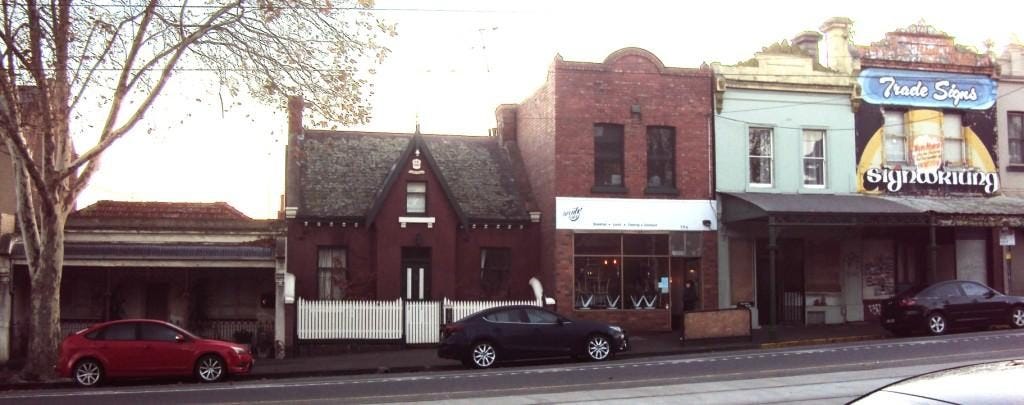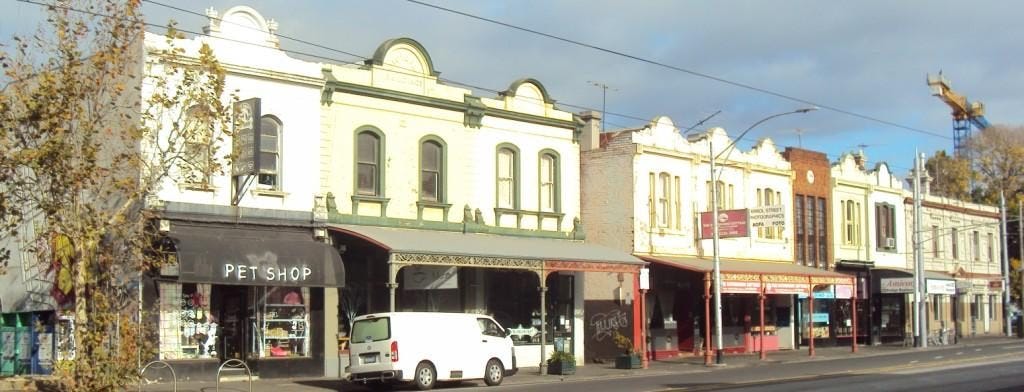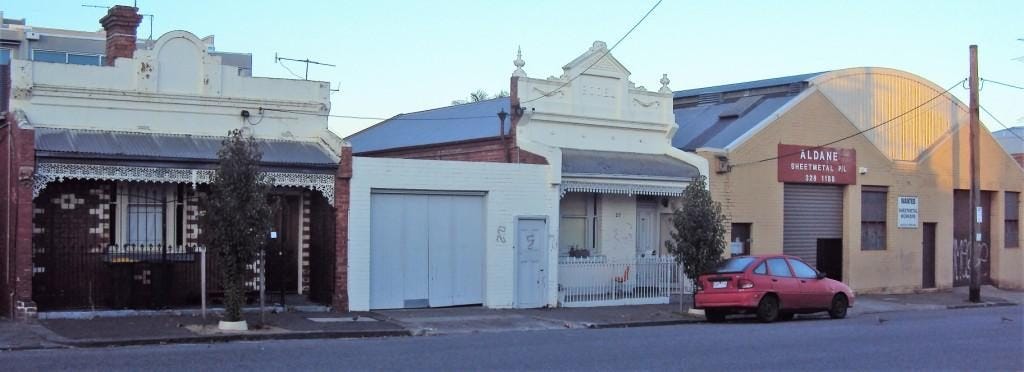Mixed use ground floor - North Melbourne
Wikipedia calls North Melbourne’s Errol Street ‘something of an upmarket strip’. However, the median weekly household income in North Melbourne is 14% lower than the national median. So it is not money that makes this ‘upmarket’. It does have a strong migrant mix with most people being born outside of Australia, and ‘its residences are a mix of established and new housing with commercial, industrial, retail and community facilities scattered throughout’, so let’s assume it is the rich mix that makes this place feel upmarket.
The Errol Street strip has a concentration of cafes and restaurants, which makes it the starting point for a good meal out. The positive side effect of the increasing real estate value of the 22-odd cafes and restaurants on Errol Street comes from the spill-over into neighbouring street, where people will try creating something special that takes people away from the strip, but is still not far from the Errol Street area. The organic nature of town centres is that they move; in time the 6+ cafes and restaurants on Queensberry Street (above) or 8+ on Victoria Street (below) may become the next coolest streets in North Melbourne.
In the early 1990s Hamilton town planners said that
“The future is likely to see a continuation of these trends with the possible development of such other overseas trends as television ordering and the like” (ref 1).
For cafes and restaurants to grow, having the customer base clustered helps; but for cool retail, having a good understanding of online shopping habits is needed to pull in new clients. One example is the ‘Lekker-bike’ shop in a back street in North Melbourne; you are not going to find it because other bike shops are grouped nearby. Then there is the on-line gift shop, ‘the-basket–case’, number 247 in the photo below, which is next to a private dwelling to its left and an architect’s office to its right, then more residential dwellings that may one day change or not change to other uses.
In the 1960s Hamilton’s District Scheme used zoning to avoid the “indiscriminate mixture of uses” (ref 2). In January 1967, it became “mandatory to zone all land” (ref 3). Sheet-metal was under User Group 14 Heavy Industry (Ref 4). Of the 10 zones, Group 14 is permitted in Industrial C & D Zones and conditional use is permitted in Industrial B & Rural Zones. In North Melbourne, sheet-metal workshops are ‘on the street where and how they want and decide and it is right and convenient for them’ (ref 5).
There is more to Baillie Street Opposite the sheet-metal workshop is a new apartment building and from the middle of the street one can see ‘indiscriminate mixture of uses’ (Ref 2). Point to note: Modern zoning was introduced to protect public health and allow industry to pollute [including via noise] away from residential areas. Hamilton’s zoning rules may be more about assumptions and political values than about managing nuisance or what actually happens in the real world.
Point 1 - When demand for retail space reduces in area zoned ‘incidental residence’ the space is converted to other uses including residential, this zone does “allow maximum flexibility in land use so that buildings get renovated and economic activities take place to pay the taxes to maintain a high level of services” (ref 6)
Ref 1 - 1991 – City of Hamilton Town Plan – Second Review of the Hamilton District Planning Scheme – REF-S-711-409-931-151-HAM - 2.11.1 Suburban Commercial Centres - 'The future is likely to see a continuation of these trends with the possible development of such other overseas trends as television ordering and the like.'
Ref 2 - Hamilton District Scheme – Section One – Scheme Statement – 1960s - page 4 - 6.2 Future Development - Future building and other development in the development in the district shall be so directed as to avoid the indiscriminate mixture of uses, with the object of economising in the servicing of the district and maintaining the stability of individual; property values.”
Ref 3 - Hamilton District Scheme – Section One – 3 Planning objectives – Page 13 – In January 1967, the Act was amended to make it mandatory to zone all land (other than existing highways). l List Accent
Ref 4 - Hamilton District Scheme - 1960s page 6 - Sheet-metal was under User Group 14 Heavy Industry
Ref 5 - In 1366, Duke Ernst I authorized the citizens of Göttingen “that they like to build, set and make their department store and town hall in Göttingen on the street ... where and how they want and decide and it is right and convenient for them”.
Ref 6 – Zoned in the USA, by Sonia Hirt. Chapter 3 - How others do it – France - page 71 Quote “from French colleague.”







